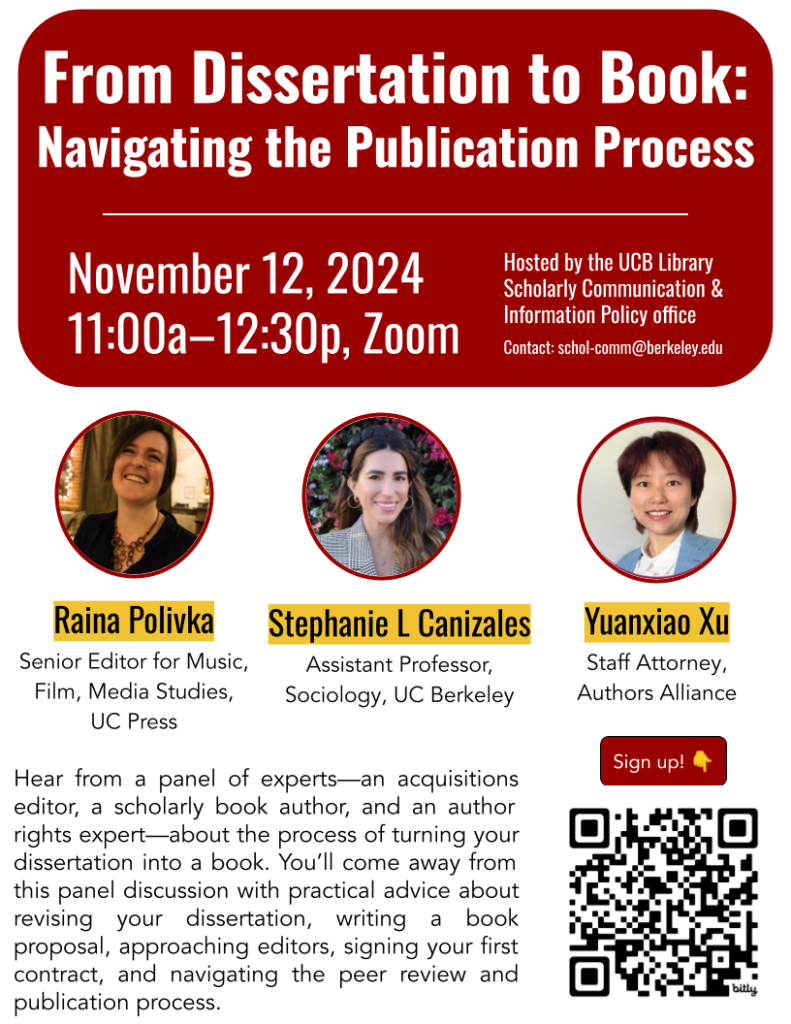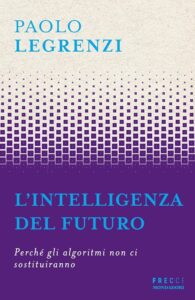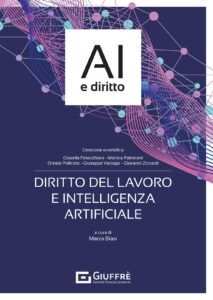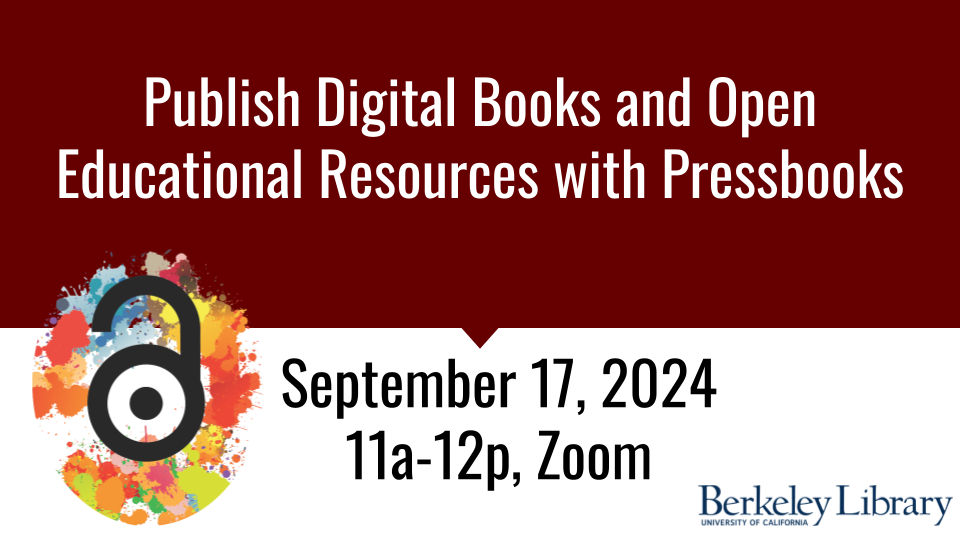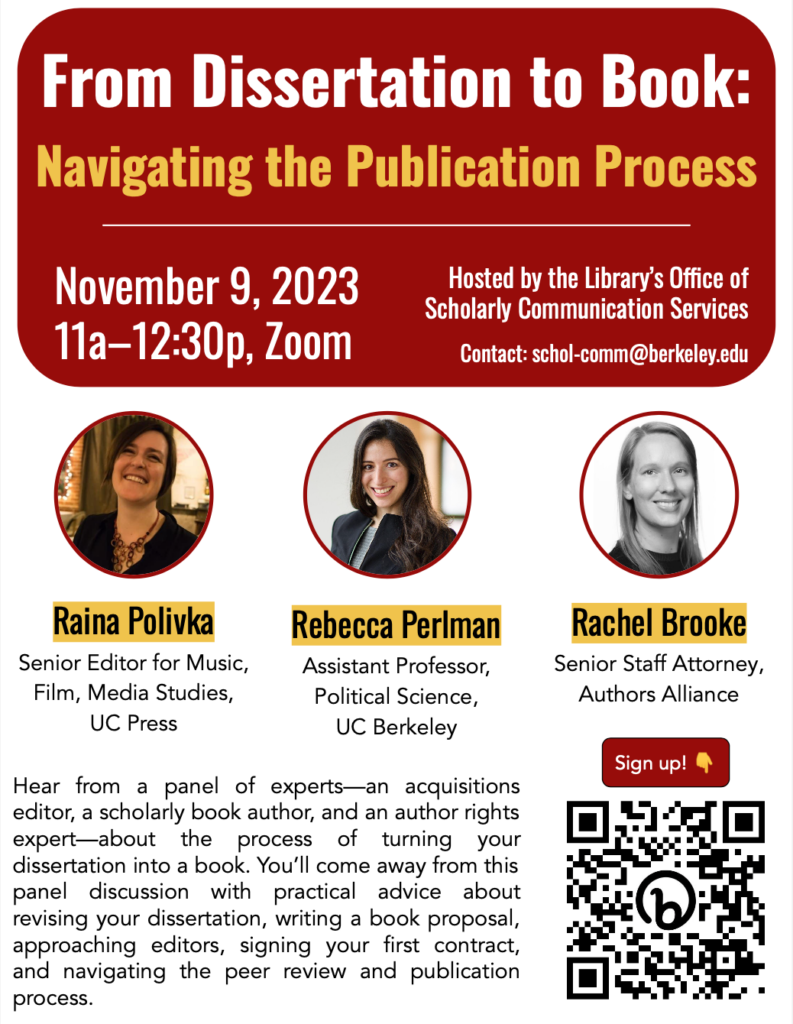Tag: book publishing
A&H Data: Designing Visualizations in Google Maps
This map shows the locations of the bookstores, printers, and publishers in San Francisco in 1955 according to Polk’s Directory (SFPL link). The map highlights the quantity thereof as well as their centrality in the downtown. That number combined with location suggests that publishing was a thriving industry.
Using my 1955 publishing dataset in Google My Maps (https://www.google.com/maps/d) I have linked the directory addresses of those business categories with a contemporary street map and used different colors to highlight the different types. The contemporary street map allows people to get a sense of how the old data compares to what they know (if anything) about the modern city.
My initial Google My Map, however, was a bit hard to see because of the lack of contrast between my points as well as how they blended in with the base map. One of the things that I like to keep in mind when working with digital tools is that I can often change things. Here, I’m going to poke at and modify my
- Base map
- Point colors
- Information panels
- Sharing settings
My goal in doing so is to make the information I want to understand for my research more visible. I want, for example, to be able to easily differentiate between the 1955 publishing and printing houses versus booksellers. Here, contrasting against the above, is the map from the last post:
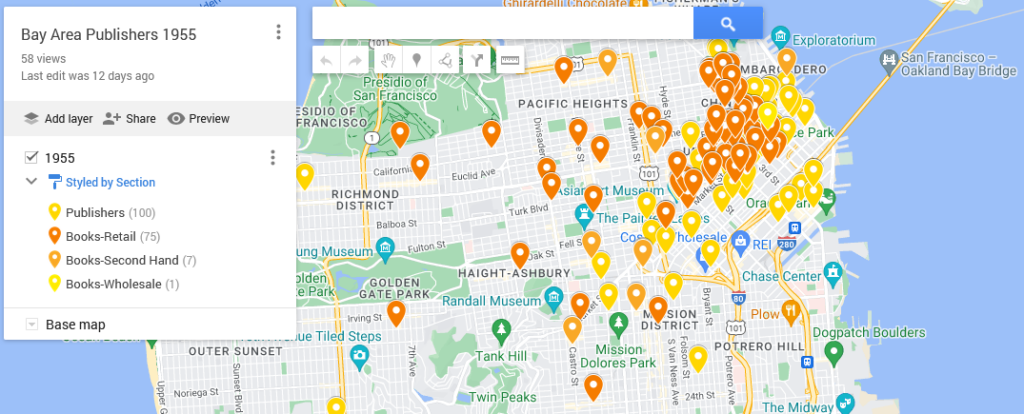
Quick Reminder About the Initial Map
To map data with geographic coordinates, one needs to head to a GIS program (US.gov discussion of). In part because I didn’t yet have the latitude and longitude coordinates filled in, I headed over to Google My Maps. I wrote about this last post, so I shan’t go into much detail. Briefly, those steps included:
-
- Logging into Google My Maps (https://www.google.com/maps/d/)
- Clicking the “Create a New Map” button
- Uploading the data as a CSV sheet (or attaching a Google Sheet)
- Naming the Map something relevant
Now that I have the map, I want to make the initial conclusions within my work from a couple weeks ago stand out. To do that, I logged back into My Maps and opened up the saved “Bay Area Publishers 1955.”
Base Map
One of the reasons that Google can provide My Maps at no direct charge is because of their advertising revenue. To create an effective visual, I want to be able to identify what information I have without losing my data among all the ads.
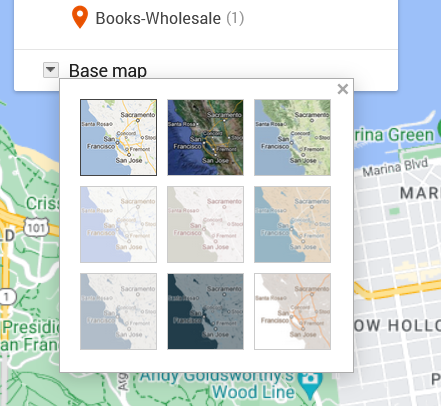
To move in that direction, I head over to the My Map edit panel where there is a “Base map” option with a down arrow. Hitting that down arrow, I am presented with an option of nine different maps. What works for me at any given moment depends on the type of information I want my data paired with.
The default for Google Maps is a street map. That street map emphasizes business locations and roads in order to look for directions. Some of Google’s My Maps’ other options focus on geographic features, such as mountains or oceans. Because I’m interested in San Francisco publishing, I want a sense of the urban landscape and proximity. I don’t particularly need a map focused on ocean currents. What I do want is a street map with dimmer colors than Google’s standard base map so that my data layer is distinguishable from Google’s landmarks, stores, and other points of interest.
Nonetheless, when there are only nine maps available, I like to try them all. I love maps and enjoy seeing the different options, colors, and features, despite the fact that I already know these maps well.
The options that I’m actually considering are “Light Political” (option center left in the grid) “Mono City” (center of the grid) or “White Water” (bottom right). These base map options focus on that lighter-toned background I want, which allows my dataset points to stand clearly against them.
For me, “Light Political” is too pale. With white streets on light gray, the streets end up sinking into the background, losing some of the urban landscape that I’m interested in. The bright, light blue of the ocean also draws attention away from the city and toward the border, which is precisely what it wants to do as a political map.
I like “Mono City” better as it allows my points to pop against a pale background while the ocean doesn’t draw focus to the border.
Of these options, however, I’m going to go with the “White Water” street map. Here, the city is done up with various grays and oranges, warming the map in contrast to “Mono City.” The particular style also adds detail to some of the geographic landmarks, drawing attention to the city as a lived space. Consequently, even though the white water creeps me out a bit, this map gets closest to what I want in my research’s message. I also know that for this data set, I can arrange the map zoom to limit the amount of water displayed on the screen.
Point colors
Now that I’ve got my base map, I’m on to choosing point colors. I want them to reflect my main research interests, but I’ve also got to pick within the scope of the limited options that Google provides.
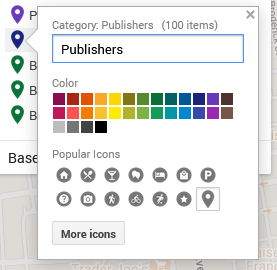
I head over to the Edit/Data pane in the My Maps interface. There, I can “Style” the dataset. Specifically, I can tell the GIS program to color my markers by the information in any one of my columns. I could have points all colored by year (here, 1955) or state (California), rendering them monochromatic. I could go by latitude or name and individually select a color for each point. If I did that, I’d run up against Google’s limited, 30-color palette and end up with lots of random point colors before Google defaulted to coloring the rest gray.
What I choose here is the types of business, which are listed under the column labeled “section.”
In that column, I have publishers, printers, and three different types of booksellers:
- Printers-Book and Commercial
- Publishers
- Books-Retail
- Books-Second Hand
- Books-Wholesale
To make these stand out nicely against my base map, I chose contrasting colors. After all, using contrasting colors can be an easy way to make one bit of information stand out against another.
In this situation, my chosen base map has quite a bit of light grays and oranges. Glancing at my handy color wheel, I can see purples are opposite the oranges. Looking at the purples in Google’s options, I choose a darker color to contrast the light map. That’s one down.
For the next, I want Publishers to compliment Printers but be a clearly separate category. To meet that goal, I picked a darker purply-blue shade.
Moving to Books-Retail, I want them to stand as a separate category from the Printers and Publishers. I want them to complement my purples and still stand out against the grays and oranges. To do that, I go for one of Google’s dark greens.
Looking at the last two categories, I don’t particularly care if people can immediately differentiate the second-hand or wholesale bookstores from the retail category. Having too many colors can also be distracting. To minimize clutter of message, I’m going to make all the bookstores the same color.
Pop-ups/ Information Dock
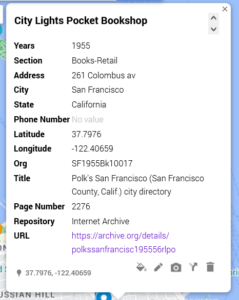
For this dataset, the pop-ups are not overly important. What matters for my argument here is the spread. Nonetheless, I want to be aware of what people will see if they click on my different data points.
[Citylights pop-up right]
In this shot, I have an example of what other people will see. Essentially, it’s all of the columns converted to a single-entry form. I can edit these if desired and—importantly—add things like latitude and longitude.
The easiest way to drop information from the pop-up is to delete the column from the data sheet and re-import the data.
Sharing
As I finish up my map, I need to decide whether I want to keep it private (the default) or share it. Some of my maps, I keep private because they’re lists of favorite restaurants or loosely planned vacations. For example, a sibling is planning on getting married in Cadiz in Spain, and I have a map tagging places I am considering for my travel itinerary.
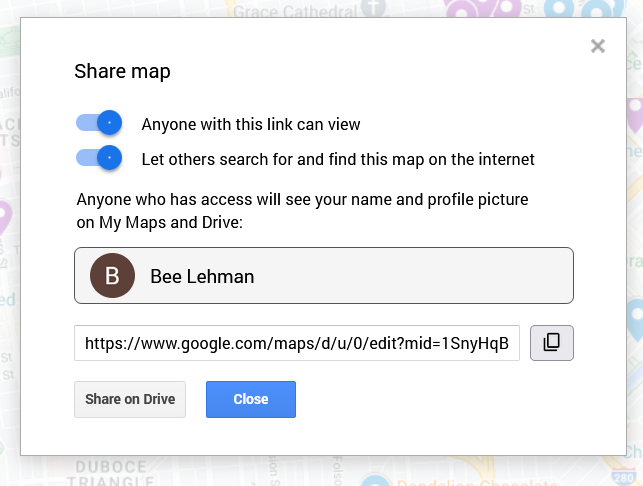
Here, in contrast, I want friends and fellow interested parties to be able to see it and find it. To make sure that’s possible, I clicked on “Share” above my layers. On the pop-up (as figured here) I switched the toggles to allow “Anyone with this link [to] view” and “Let others search for and find this map on the internet.” The latter, in theory, will permit people searching for 1955 publishing data in San Francisco to find my beautiful, high-contrast map.
Important: This is also where I can find the link to share the published version of the map. If I pull the link from the top of my window, I’d share the editable version. Be aware, however, that the editable and public versions look a pinch different. As embedded at the top of this post, the published version will not allow the viewer to edit the material and will have the sidebar for showing my information, as opposed to the edit view’s pop-ups.
Next steps
To see how those institutions sit in the 1950s world, I am inclined to see how those plots align across a 1950s San Francisco map. To do that, I’d need to find an appropriate map and add a layer under my dataset. At this time, however, Google Maps does not allow me to add image and/or map layers. So, in two weeks I’ll write about importing image layers into Esri’s ArcGIS.
Open access book publishing at UC Berkeley: Fall 2024 update

UC Berkeley supports a variety of ways our authors can participate in open access publishing. At its heart, open access literature is “digital, online, free of charge, and free of most copyright and licensing restrictions” (Suber, 2019). Open access materials can be read and used by anyone.
But you might be wondering, why is UC Berkeley concerned about trying to make research more openly available and accessible? Well, one fundamental reason is that the research and teaching mission of the UC includes the aim of “transmitting advanced knowledge,” and as part of doing that, our faculty, researchers, and students create and share their scholarship.
This system of scholarly publishing includes traditional publications such as peer-reviewed academic articles, scholarly chapters or books, and conference proceedings. It also includes other types of publications such as digital projects, data sets and visualizations, and working papers.
In this blog post, we’ll provide an update on how the UC Berkeley Library is fostering open access book publishing. And we’ll also highlight the current progress on supporting OA publishing of scholarly articles.
Library Support for Open Access Books
We know that not all University of California authors are publishing journal articles, and many disciplines—such as arts, humanities, and social sciences—focus on the scholarly monograph as the preferred mode of publishing. Some open access book publishers charge authors (or an author’s institution) a fee in exchange for publishing the book open access, similar to the practice of academic journal publishers charging an “article processing charge” to make a research article open access.
Book authors can realize a variety of benefits with open access publishing, including increasing the reach of their scholarship, building relationships within their academic discipline, garnering more citations, making their scholarly books more affordable for students, improving accessibility for print-disabled users, and more.
UC Berkeley is supporting authors who wish to publish their books open access. The library provides funding assistance and access to publishing platforms and tools for authors to make their books OA.
Berkeley Research Impact Initiative books
The Berkeley Research Impact Initiative (BRII) is a program to foster broad public access to the work of scholars by encouraging the UCB community to take advantage of open access publishing opportunities—including books and journal articles. BRII is the local open access fund that helps defray the costs associated with publishing open access books and research articles. For books, BRII can contribute up to $10,000 per book for it to be published open access. Below are recent UCB-authored books published with the assistance of BRII.
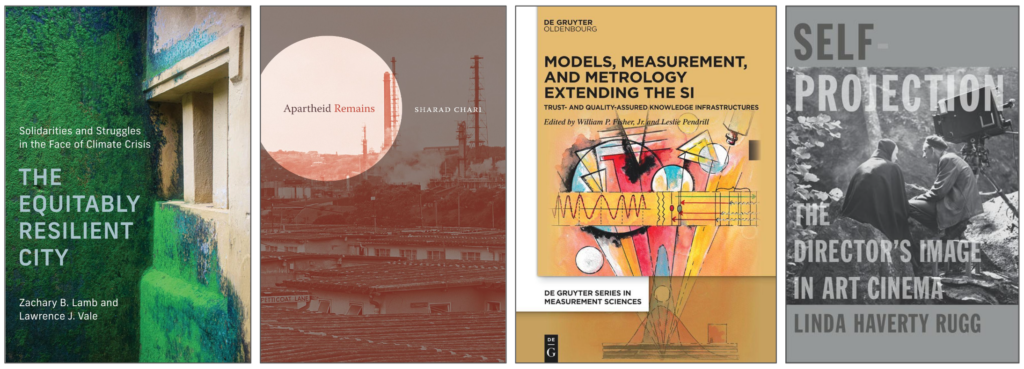
The Equitably Resilient City
- Zachary B. Lamb (Assistant Professor, City and Regional Planning, UC Berkeley) and Lawrence J. Vale (MIT)
- MIT Press
- Open Access download
Apartheid Remains
- Sharad Chari (Associate Professor, Geography, UC Berkeley)
- Duke University Press
- Open Access download
Models, Measurement, and Metrology Extending the SI: Trust and Quality Assured Knowledge Infrastructures
- William P. Fisher, Jr. (Graduate School of Education, UC Berkeley), Leslie Pendrill (RISE Research Institutes of Sweden)
- De Gruyter
- Open Access download
Self-Projection: The Director’s Image in Art Cinema
- Linda Haverty Rugg (Professor of Scandinavian Culture, Literature and Film, UC Berkeley)
- University of Minnesota Press
- Open Access download
Springer Open Access books
Since 2021, the UC Berkeley Library has had an institutional open access book agreement with Springer Nature. The partnership provides open access funding to UC Berkeley affiliated authors who have books accepted for publication in Springer, Palgrave, and Apress imprints. This means that these authors can publish their books open access at no direct cost to them. The agreement covers all disciplines published by Springer. Every book is published under a Creative Commons Attribution (CC BY) license for free access and downloading. Here are a few recent books published open access as a result of the UCB-Springer agreement.
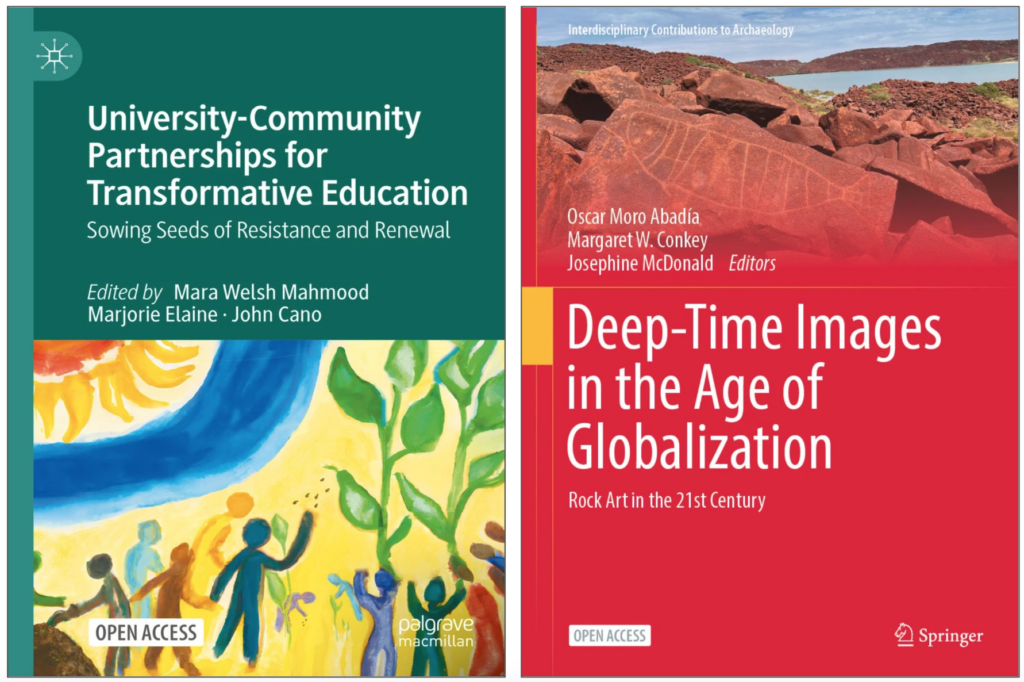
University-Community Partnerships for Transformative Education: Sowing Seeds of Resistance and Renewal
- Mara Welsh Mahmood (School of Education, UC Berkeley), John Cano (School of Education, UC Berkeley), Marjorie Elaine (School of Education and Information Studies, UCLA)
- Palgrave Macmillan
- Open Access download
This open access edited volume reports on a unique network of innovative in-school and out-of-school programs, University-Community Links (UC Links), which is coordinated through the UC Links Office in the Berkeley School of Education. UC Links connects university faculty and students with young people and their families in diverse communities around the world. University-Community Partnerships for Transformative Education: Sowing Seeds of Resistance and Renewal includes 20 chapters describing university-community partnerships and programs in California in the US as well as Germany, Italy, Spain, Uganda, and Uruguay (both in English and Spanish!). The volume also includes first-person reflections describing how participation in UC Links programs has transformed participants’ thinking about teaching and learning and also has transformed individual lives.
Co-editor Mara Welsh Mahmood says:
“It was imperative to all contributing authors that the knowledge and experiences described in this volume be accessible to anyone interested in learning more about these university-community partnership programs. Authors envisioned using the chapters in their courses and also being able to share them with school and community partners without associated costs. The UC Berkeley Open Access agreement with Springer allows this book to be given away—young people who contributed first-person narratives can share this with their families and friends; academic scholars interested in developing a partnership with a local school or community can easily point people to the book to learn more about what these partnerships can look like in practice. Already the book has been accessed 16,000 times after two months of publication!”
Deep-Time Images in the Age of Globalization: Rock Art in the 21st Century
- Margaret W. Conkey (Professor Emerita of Anthropology, UC Berkeley), Oscar Moro Abadía (Memorial University of Newfoundland), Josephine McDonald (University of Western Australia)
- Springer
- Open Access download
University of California Press
UC Berkeley Library continues to support open access book publishing via Luminos, the open access arm of the University of California Press. The Library membership with Luminos means that UC Berkeley authors who have books accepted for publication through the UC Press can publish their book open access with a heavily discounted book processing charge. When combined with additional funding support through BRII, a UC Berkeley book author could potentially publish their book open access with the costs being covered fully by the Library. Luminos books are published under Creative Commons licenses with free downloads.
Pressbooks platform & workshops
The UC Berkeley Library hosts an instance of Pressbooks, an online platform through which the UCB community members can create open access books, open educational resources (OER), and other types of digital scholarship.
The Scholarly Communication & Information Policy (SCIP) office continues to offer twice/year Pressbooks workshop and demo where participants can learn how to navigate the platform and create and publish their own eBooks and open educational resources. (Note: we just hosted a workshop in September, but watch out for another one coming soon.)
Every year during the fall semester SCIP hosts an author panel to unpack the process of turning a dissertation into a book. One of the topics discussed during the panel are options for open access publishing. RSVP now for the upcoming author panel on November 12, 2024, 11:00am-12:30pm.
UC contributing to the broader ecosystem of open access book publishing
A goal of the UC Libraries is to strategically advance open scholarship by extending its support for OA book publishing. At the systemwide level, the UC is contributing to several open access book publishing ventures, including Opening the Future, MIT’s Direct to Open, the University of Michigan Press’ Fund to Mission, and the Open Book Collective. In general, these models secure investments from libraries or other stakeholders, and agree to publish some or all of their frontlist books open access, with limited or zero direct cost to the authors. The backlist books are made accessible to participating institutions.
Library Support for Open Access Articles
While the topic of this post focuses mainly on open access books, UC Berkeley (and the UC more generally) offers a wide range of support to help authors publish scholarly articles. The UC’s system-wide Open Access Policies ensure that university-affiliated authors can deposit their final, peer-reviewed research articles into eScholarship, our institutional repository, immediately upon publication in a journal. Once they’re in eScholarship, the articles may be read by anyone for free (not to mentioned preserved for longer term access).
As of October 2024, the University of California has entered into 24 system-wide Open Access Publishing Agreements and Discounts with scholarly publishers (most recently a new agreement with Taylor & Francis). These agreements permit UC corresponding authors to publish open access in covered journals, with the publishing fees being covered in part (or in full) by the UC. In fiscal year 2023-24 UC Berkeley authors published 527 open access articles as a part of these system wide open access publishing agreements.
Locally, the UC Berkeley Library continues to offer the Berkeley Research Impact Initiative (BRII). This program helps UC Berkeley authors defray article processing charges (APCs) that are sometimes required to publish in fully open access journals (note that BRII doesn’t reimburse authors for publishing in “hybrid” journals—that is, subscription journals that simply offer a separate option to pay to make an individual article open access). This past year BRII provided funding for the publication of 45 open access articles. UC Berkeley authors can take advantage of BRII assistance where there is no other system wide open access agreement in place.
Wrapping up
In this post, we highlighted several ways that the University of California—and specifically UC Berkeley—is supporting scholarly authors to create and share open access books. In addition to providing financial assistance, platforms, and publishing guidance, the Library is committed to promoting the broader OA book publishing ecosystem. We’ll continue to explore a variety of approaches to support the UC Berkeley community (and beyond) who wish to publish books on open access terms.
If you’re interested to learn more about how you can create and publish an open access book, visit our website or send an email to schol-comm@berkeley.edu.
Intelligenza Artificiale in Italia
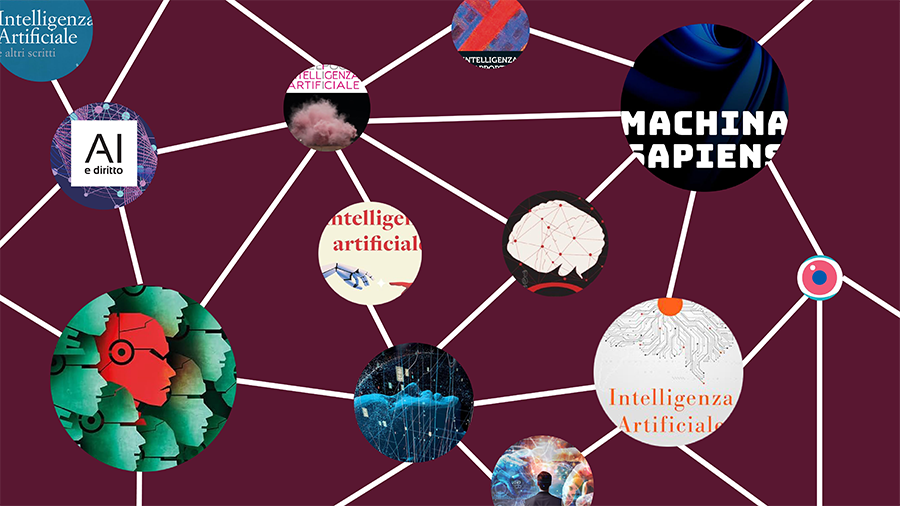
Judging by the explosion of new books on artificial intelligence, or AI, being published in Italy, you might think this Mediterranean country is the the editorial epicenter for one of the hottest interdisciplinary topics. Whether you are in the humanities, social sciences, human sciences, computer science, or STEM fields, “intelligenza artificiale” as it’s called in Italian will eventually find its way into your coursework or research. Here are just a few of the books on AI to recently reach bookstores in Italy and that have not automatically been sent to the UC Berkeley Library. However, if you are inclined just let your friendly Romance languages librarian know and he’ll be happy to push the first button to initiate this demand-driven order.*
-
Amore, Nicolò and Eleonora Rossero. Robotica e intelligenza artificiale nell’attività medica. Organizzazione, autonomia, responsabilità. Bologna: Il Mulino, 2024.
-
Bezzecchi, Emanuele. Intelligenza artificiale. Farsi le domande giuste, capire gli scenari futuri e usare in modo smart l’IA generativa. Milano: Vallardi, 2024.
-
Biasi Marco, editor. Diritto del lavoro e intelligenza artificiale. Giuffrè, 2024.
-
Butera, Federico and Giorgio De Michelis. Intelligenza artificiale e lavoro, una rivoluzione governabile. Venezia: Marsilio, 2024.
-
Caligiore, Daniele. Curarsi con l’intelligenza artificiale. Bologna: Il Mulino, 2024.
-
Canali, Chiara and Rebecca Pedrazzi. L’Opera d’arte nell’epoca dell’intelligenza artificiale. Milano: Jaca Book, 2024.
-
Corrado, Vincenzo and Stefano Pasta. Intelligenza artificiale e sapienza del cuore. Commento al Messaggio di Papa Francesco per la 58ma Giornata mondiale delle Comunicazioni Sociali. Brescia: Morcelliana, 2024.
-
Cristiani, Nello. Machina sapiens. L’algoritmo che ci ha rubato il segreto della conoscenza. Bologna: Il Mulino, 2024.
-
Di Dio Roccazzella, Marco and Frank Pagano, editors. Intelligenza artificiale. Arte e scienza nel business. Il Sole 24 Ore, 2023.
-
D’Isa, Francesco. La Rivoluzione Algoritmica delle Immagini: Arte e Intelligenza Artificiale. Luca Sossella Editore, 2023.
-
Fanni, Rosanna et al. Guerre di macchine. Intelligenza artificiale tra etica ed efficacia. Guerini e Associati, 2024.
-
Formica, Piero. Intelligenza umana e intelligenza artificiale. Un’esposizione nella Galleria della Mente. Pendragon, 2024.
-
Gulisano, Paolo. Imperativo tecnologico: La sfida etica dell’intelligenza artificiale. Idrovolante Edizioni, 2024.
-
Iaselli, Michele. La protezione dei dati nell’era dell’intelligenza artificiale. 2024.
-
Legrenzi, Paolo. L’intelligenza del futuro. Perché gli algoritmi non ci sostituiranno. Milano: Mondadori, 2024.
-
Mari, Luca. L’Intelligenza artificiale in Dostoevskij. Riflessioni sul futuro, la conoscenza, la responsabilità umana. Il Sole 24 Ore, 2024.
-
Narmenni, Francesco. Conversazioni con l’intelligenza artificiale. Il Punto d’Incontro, 2023.
-
Pajno, Alessandro et al, editors. Intelligenza e diritto: una rivoluzione? Vol. 1. Diritti fondamentali, dati personali e regolazione. Bologna: Il Mulino, 2022.
-
Pasqualetti, Fabio, and Vittorio Sammarco, editors. Intelligenza artificiale: In cerca di umanità. LAS, Percorsi di Comunicazione, 2023.
-
Proto, Massimo. Intelligenza artificiale e rapporti bancari. Umano e non umano nelle relazioni tra intermediari e clienti. Pacini Giuridica, 2024.
-
Sini, Carlo. Intelligenza artificiale e altri scritti. Milano: Jaca Book, 2024.
*Demand-driven acquisition (DDA), is a model of library collection development in which a library only purchases materials when it is clear that a patron has demonstrated the need for a resource. If implemented correctly, DDA can make it possible to purchase only what is needed, allowing libraries to spend the same amount of money as they previously spent on monographs, but with a higher rate of use.
Panel reminder — From Dissertation to Book: Navigating the Publication Process
Date/Time: Tuesday, November 12, 2024, 11:00am–12:30pm
Location: Zoom. RSVP.
Hear from a panel of experts—an acquisitions editor, a first-time book author, and an author rights expert—about the process of turning your dissertation into a book. You’ll come away from this panel discussion with practical advice about revising your dissertation, writing a book proposal, approaching editors, signing your first contract, and navigating the peer review and publication process.
We’ll be joined by:
- Raina Polivka, Senior Editor for Music, Film, Media Studies, University of California Press
- Prof. Stephanie L. Canizales, Assistant Professor, Sociology, UC Berkeley – and author of the recently-published Sin Padres, Ni Papeles: Unaccompanied Migrant Youth Coming of Age in the United States (2024, UC Press)
- Yuanxiao Xu, Staff Attorney, Authors Alliance
Workshop reminder — Publish Digital Books & Open Educational Resources with Pressbooks
Date/Time: Tuesday, September 17, 2024, 11:00am–12:00pm
Location: Zoom. RSVP.
If you’re looking to self-publish work of any length and want an easy-to-use tool that offers a high degree of customization, allows flexibility with publishing formats (EPUB, PDF), and provides web-hosting options, Pressbooks may be great for you. Pressbooks is often the tool of choice for academics creating digital books, open textbooks, and open educational resources, since you can license your materials for reuse however you desire. Learn why and how to use Pressbooks for publishing your original books or course materials. You’ll leave the workshop with a project already under way.
Curious about how UC Berkeley faculty, students, and staff have used Pressbooks? Check out some of the Berkeley-created digital books and resources below, or browse over 7,200 open access books on the Pressbooks Directory.
Upcoming Workshop: Publish Digital Books and Open Educational Resources with Pressbooks
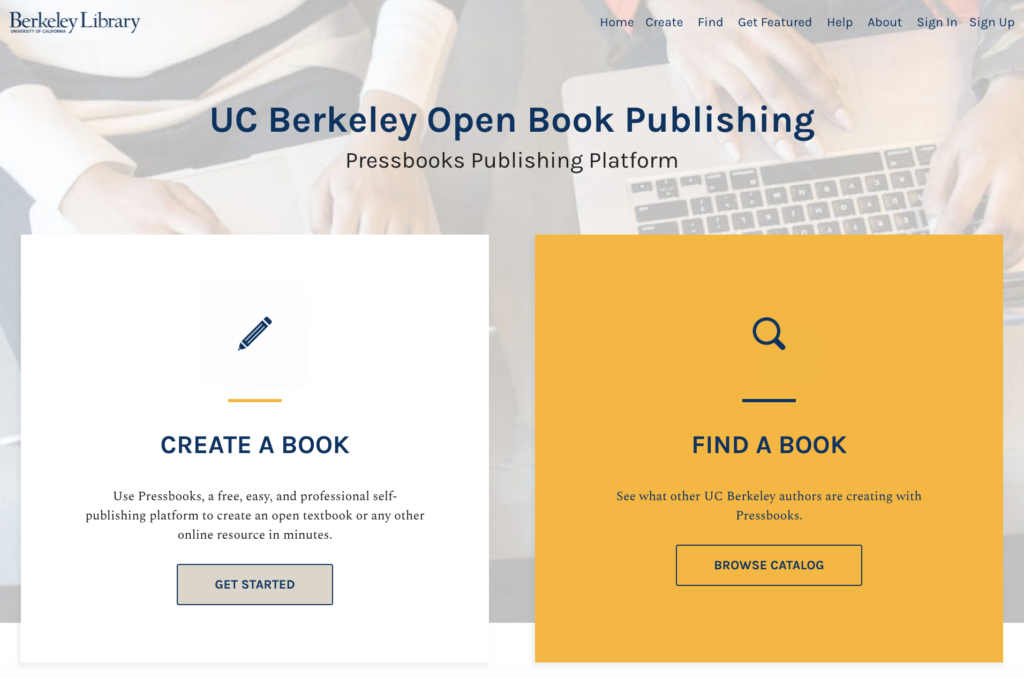
Workshop Date/Time: Tuesday, April 9, 2024, 11:00am–12:30pm
Register to receive Zoom link
If you’re looking to self-publish work of any length and want an easy-to-use tool that offers a high degree of customization, allows flexibility with publishing formats (EPUB, PDF), and provides web-hosting options, Pressbooks may be great for you. Pressbooks is often the tool of choice for academics creating digital books, open textbooks, and open educational resources, since you can license your materials for reuse however you desire. Learn why and how to use Pressbooks for publishing your original books or course materials. You’ll leave the workshop with a project already under way! Signup at the link above and the Zoom login details will be emailed to you.
Please sign up today and join us online on April 9.
Workshop Reminder — From Dissertation to Book: Navigating the Publication Process on November 9, 2023
Date/Time: Thursday, November 9, 2023, 11:00am–12:30pm
Location: Zoom only. Register via LibCal.
Hear from a panel of experts—an acquisitions editor, a first-time book author, and an author rights expert—about the process of turning your dissertation into a book. You’ll come away from this panel discussion with practical advice about revising your dissertation, writing a book proposal, approaching editors, signing your first contract, and navigating the peer review and publication process.
EVENT: Getting your book published open access: a panel discussion with Springer Nature and UC Berkeley
Are you a scholarly author interested in publishing a book, but unfamiliar with how to find an editor or press? Have you considered publishing that book open access and want to understand your open access book publishing options?
Springer Nature and UC Berkeley invite you to join us for a virtual panel discussion.
Hear from a panel of Springer Nature Open Access Books Editors in both STM and the Humanities, and a recent author about the process of getting your manuscript published.
You’ll come away from this discussion with practical advice about opportunities at UC Berkeley to publish open access books with Springer Nature, and guidance for submitting and revising your work, writing a book proposal, approaching editors, signing your first contract, and navigating the peer review and publication process.
While the event is focused on supporting UC Berkeley authors, it is open to all, as other institutions may be interested in entering into open access book agreements with publishers.
When: Monday, 14th March 2022; 11am-12:15pm PDT
Where: https://us06web.zoom.us/webinar/register/WN_VhjMRxIhQ3CmhYuPDv0nGw
RSVP: Please click on the link above to register and you’ll receive a Zoom link to join on the day.
— — — — —
Just FYI, here are a few of the UCB authored/edited books made available OA through the agreement so far. There are several more in the works.
- Natasha Distiller – Complicities: A theory for subjectivity in the psychological humanities
- Jean Walrand – Probability in Electrical Engineering and Computer Science
- Joan DeJaeghere, Erin Murphy-Graham – Life Skills Education for Youth
Getting your book published open access: a panel discussion with Springer Nature and UC Berkeley

Photo by Haneen Krimly on Unsplash
Are you a scholarly author interested in publishing a book, but unfamiliar with how to find an editor or press? Have you considered publishing that book open access and want to understand your open access book publishing options?
Springer Nature and UC Berkeley invite you to join us for a virtual panel discussion.
Hear from a panel of Springer Nature Open Access Books Editors in both STM and the Humanities, and a recent author about the process of getting your manuscript published.
You’ll come away from this discussion with practical advice about opportunities at UC Berkeley to publish open access books with Springer Nature, and guidance for submitting and revising your work, writing a book proposal, approaching editors, signing your first contract, and navigating the peer review and publication process.
While the event is focused on supporting UC Berkeley authors, it is open to all, as other institutions may be interested in entering into open access book agreements with publishers.
When: Monday, 14th March 2022; 11am-12:15pm PDT
Where: https://us06web.zoom.us/webinar/register/WN_VhjMRxIhQ3CmhYuPDv0nGw
RSVP: Please click on the link above to register and you’ll receive a Zoom link to join on the day.
